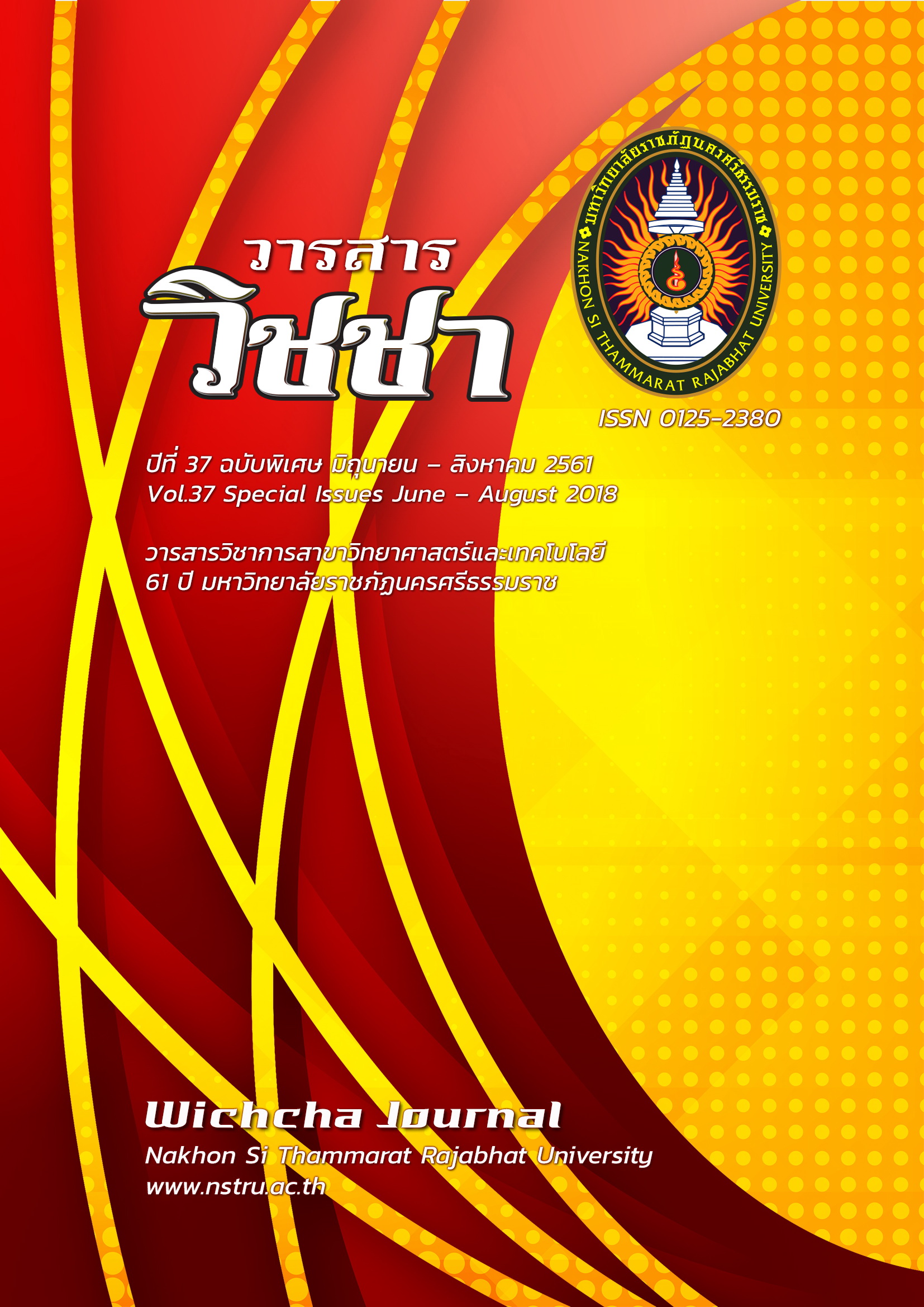การประยุกต์ใช้เปลือกกล้วยเป็นแหล่งคาร์บอนสำหรับการผลิตสารลดแรงตึงผิวชีวภาพจากแบคทีเรียที่คัดแยกได้จากดินที่ปนเปื้อนน้ำมันหล่อลื่นเครื่องยนต์ที่ใช้แล้ว
Main Article Content
Abstract
The aim of this research was to screen an effective biosurfactant - producing bacteria isolated from used lubricating oil contaminated soil collected from garage area in Phuket Rajabhat University by using banana peel as a carbon source on Minimal Salt Medium (MSM). Seven bacterial isolates were selected from 159 isolates by using drop collapsing test and emulsification activity. All seven isolates had high activity by drop collapsing test, but they do not exhibit emulsification activity with palm oil. Gram - staining and cell morphology study revealed that all seven isolates were Gram - positive and rods shape. Bacterial isolate 180 showed the highest biosurfactant activity by drop collapsing test (8.50 mm). The optimized conditions for biosurfactant production of bacterial isolate 180 was performed in MSM supplemented with banana peel as a carbon source. The optimized condition was obtained when supplemented with 1% banana peel as a carbon source and 0.1% yeast extract as a nitrogen source incubated at 200 rpm at room temperature (30±5ºC). It exhibited the highest biosurfactant activity up to 8.00 mm after 12 hours of incubation.
Article Details
เนื้อหาและข้อมูลในบทความที่ลงตีพิมพ์ในวารสารวิชชา มหาวิทยาลัยราชภัฏนครศรีธรรมราช ถือเป็นข้อคิดเห็นและความรับผิดชอบของผู้เขียนบทความโดยตรง ซึ่งกองบรรณาธิการวารสารไม่จำเป็นต้องเห็นด้วยหรือร่วมรับผิดชอบใด ๆ
บทความ ข้อมูล เนื้อหา รูปภาพ ฯลฯ ที่ได้รับการตีพิมพ์ในวารสารวิชชา มหาวิทยาลัยราชภัฏนครศรีธรรมราช ถือเป็นลิขสิทธ์ของวารสารวิชชา มหาวิทยาลัยราชภัฏนครศรีธรรมราช หากบุคคลหรือหน่วยงานใดต้องการนำข้อมูลทั้งหมดหรือส่วนหนึ่งส่วนใดไปเผยแพร่ต่อหรือเพื่อการกระทำการใด ๆ จะต้องได้รับอนุญาตเป็นลายลักษณ์อักษรจากวารสารวิชชา มหาวิทยาลัยราชภัฏนครศรีธรรมราชก่อนเท่านั้น
The content and information in the article published in Wichcha journal Nakhon Si Thammarat Rajabhat University, It is the opinion and responsibility of the author of the article. The editorial journals do not need to agree. Or share any responsibility.
References
Batista, S.B., Mounteer, A.H., Amorim, F.R. and Totola, M.R. (2006). Isolation and characterization of biosurfactant/bioemulsifier-producing bacteria from petroleum contaminated sites. Bioresource Technology, 97(6), 868-875.
Benincasa, M., Contiero, J., Manresa, M.A. and Moraes, I.O. (2002). Rhamnolipid production by Pseudomonas aeruginosa LBI growing on soapstock as the sole carbon source. Food Engineering, 54, 283-288.
Bodour, A. and Maier, M. (1998). Application of a modified drop-collapse technique for surfactant quantitation and screening of biosurfactant-producing microorganisms. Microbiological Methods, 32(3), 273-280.
Chen, X.D., Wei, G.Y., Zhang, J.L. and Dong, Y.Y. (2011). Efficient production of glutathione using hydrolyzate of banana peel as novel substrate. Chemical Engineering, 28(7), 1566-1572.
Cherif, N., Tifrit, A., Daouadji, K.L., Mezouari, S., Chama, Z. and Abbouni, B. (2015). Effect of carbon and nitrogen source on the microbial production of biosurfactants by Pseudomonas aeruginosa. Der Pharmacia Lettre, 7 (8), 42-48.
Chooklin, C.S., Maneerat, S. and Saimmai, A. (2014). Utilization of banana peel as a novel substrate for biosurfactant production by Halobacteriaceae archaeon AS65. Applied Biochemistry and Biotechnology, 173(2), 624-645.
Cooper, D.G. and Goldenberg, B.G. (1987). Surface active agent from two Bacillus species. Applied and Environmental Microbiology, 53(2), 224-229.
Ehrhardt, D.D., Secato, J.F.F. and Tambourgi, E.B. (2015). Biosurfactant production by Bacillus subtilis using the residue from processing of pineapple, enriched with glycerol, as substrate. Chemical Engineering Transactions, 43, 277-282.
Emaga, T.H., Robert, C., Ronkart, S.N., Wathelet, B. and Paquot, M. (2008). Dietary fiber components and pectin chemical features of peels during ripening in banana and plantain varieties. Bioresource Technology, 99(10), 4346-4354.
Gnanamani, A., Kavitha, V., Radhakrishnan, N. and Mandal, A.B. (2010). Bioremediation of crude oil contamination using microbial surface-active agents: isolation, production and characterization. Bioremediation and Biodegradation, 1(2), 107-115.
Haba, E., Espuny, M.J., Busquets, M. and Manrera, A. (2000). Screening and production of ramnolipids by Psudomonas aeruginosa 47T2 NCIB 40044 from waste frying oils. Applied Microbiology, 88(3), 379-387.
Ismail, W., Shammary, S.A.L., El-Sayed, W.S., Obuekwe, C., El Nayal, A.M., Raheem, A.S.A. and Al-Humam, A. (2015). Stimulation of rhamnolipid biosurfactants production in Pseudomonas aeruginosa AK6U by organosulfur compounds provided as sulfur sources. Biotechnology Reports, 7, 55-63.
Joshi, P.A. and Shekhawat, D.B. (2014). Effect of carbon and nitrogen source on biosurfactant production by biosurfactant producing bacteria isolated from petroleum contaminated site. Advances in Applied Science Research, 5(6), 159-164.
Kiran, G.S., Nishanth, L.A., Priyadharshini, S., Anitha, K. and Selvin, J. (2014). Effect of Fe nanoparticle on growth and glycolipid biosurfactant production under solid state culture by marine Nocardiopsis sp. MSA13A. BMC Biotechnology, 14(48), 1-10.
Kumar, A.P., Janardhan, A., Viswanath, B., Monika, K., Jung, J-Y. and Narasimha, G. (2016). Evaluation of orange peel for biosurfactant production by Bacillus licheniformis and their ability to degrade naphthalene and crude oil. 3 Biotech, 6(43), 1-10.
Mabrouk, M.E.M., Youssif, E.M. and Sabry, S.A. (2014). Biosurfactant production by a newly isolated soft coral-associated marine Bacillus sp. E34: Statistical optimization and characterization. Life Science Journal, 11(10), 756-768.
Qazi, M.A., Malik, Z.A., Qureshi, G.D., Hameed, A. and Ahmed, S. (2013). Yeast extract as the most preferable substrate for optimized biosurfactant production by rhlB gene positive Pseudomonas putida SOL-10 isolate. Journal of Bioremediation and Biodegradation, 4(7), 1-10.
Rocha, M.V.P., Barreto, R.V.G., Melo, V.M. and Goncalves, L.R.B. (2009). Evaluation of cashew apple juice for surfactin production by Bacillus subtilis LAMI008. Applied Biochemistry and Biotechnology, 155(1), 366-378.
Ron, E.Z. and Rosenberg, E. (2002). Biosurfactants and oil bioremediation. Current Opinion in Biotechnology, 13, 249-252.
Saimmai, A., Sobhon, V. and Maneerat, S. (2012). Production of biosurfactant from a new and promising strain of Leucobacter komagatae 183. Annals of Microbiology, 62, 391-402.
Santos, D.K.F., Rufino, R.D., Luna, J.M., Santos, V.A. and Sarubbo, L.A. (2016). Biosurfactants: Multifunctional biomolecules of the 21st century. International Journal of Molecular Sciences, 17, 1-31.
Venables, W.N., Smith, D.M. and The R Development Core Team. (2009). An Introduction to R, Notes on R: A Programming Environment for Data Analysis and Graphics Version 3.5.0. Retrieved 23 April-2018, from: https://cran.r-project.org.
Yin, B., Gua, J.D. and Wana, N. (2005). Degradation of indole by enrichment culture and Pseudomonas aeruginosa Gs isolated from mangrove sediment. International Biodeterioration and Biodegradation, 56(4), 243-248.


